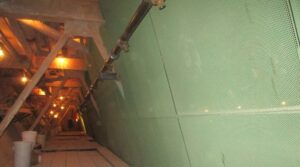Top 10 Cleaning and Inspection Challenges: No. 8
Selective Catalytic Reduction Units
Based on an extensive survey of 500 refinery operators, cleaning catalyst banks in SCR units ranks eighth among the most prevalent cleaning challenges. In this in-depth discussion, we will explore how to effectively remove pluggage and fouling from SCR screens and improve catalyst reduction system efficiency.
SCR Catalyst Screen Fouling
During operation, various residues like ceramic fiber, inorganic dust and combustion by-products tend to build up on the front end of the SCR catalyst due to the flow of flue gas. This accumulation impedes the smooth passage of gas through the catalyst, causing a rise in pressure drop across the SCR unit. To counter this issue, there’s a need to ramp up the usage of the induced draft fan, leading to additional energy consumption. Once the fan operates at its maximum capacity, production levels must be scaled back to alleviate the pressure drop across the SCR system.
What are the Consequences of SCR Fouling?
Some of the key problems associated with SCR catalyst screen fouling include:
- Reduced Efficiency
Accumulation of debris on the SCR catalyst screens obstructs the flow of flue gas, leading to decreased contact between the exhaust gases and the catalyst surface. This diminishes the catalyst’s effectiveness in converting harmful pollutants, such as nitrogen oxides (NOx), into harmless substances.
- Increased Pressure Drop
The buildup of deposits on the catalyst screens increases the resistance to gas flow, resulting in higher pressure differentials across the SCR unit. This necessitates additional energy consumption to maintain the required gas flow rates, leading to increased operational costs.
- Elevated Maintenance Frequency
Regular cleaning or replacement of fouled SCR catalyst screens becomes necessary to restore optimal performance. This increases downtime and maintenance expenses, impacting overall process efficiency and productivity.
- Risk of Catalyst Damage
Severe fouling can lead to overheating of the SCR catalyst, potentially causing thermal stress and physical damage to the catalyst material. This not only compromises catalytic activity but also necessitates costly repairs or replacement of the affected components.
- Compliance Issues
Failure to address SCR catalyst screen fouling can result in non-compliance with environmental regulations governing emissions control. Exceeding permitted emission levels can lead to regulatory fines and penalties, as well as damage to your reputation.
Solutions
Ideally, facilities should implement effective fouling mitigation strategies, such as regular maintenance, optimized operating conditions, and using advanced catalyst cleaning technologies. Additionally, investing in high-quality SCR catalyst screens designed to resist fouling can help mitigate these issues and ensure efficient operation of the SCR system over the long term.
How Can You Clean SCR Units Without Taking Them Offline?
IGS Cetek offers an on-line cleaning solution for selective catalyst banks that addresses production interruptions and environmental concerns. The approach involves utilizing existing access points or creating reusable ones through a hot access creation service, ensuring integration of equipment upstream of the catalyst.
The process begins with inserting a vacuum lance equipped with a non-damaging, low-friction tip into the ducting. Skilled technicians carefully manipulate the lance to remove surface debris from the catalyst without causing harm. Whether through direct observation or a Lancescope viewing system, visibility is maintained during the vacuuming process as it progresses port by port along the catalyst wall. Each access point is promptly closed before moving to the next, ensuring thorough cleaning without disruption.
By eliminating fouling and restoring optimal gas flow, the hot vacuum service allows syngas production to resume normal levels while reducing the usage of ID fans. This maximizes SCR catalyst bank efficiency, minimizes energy wastage, and reduces strain on fan motors. Moreover, it mitigates the risk of production curtailment due to blockages or excessive NOx emissions, enhancing DeNOx potential and mercury oxidation for improved SCR performance.
Conclusion
Addressing selective catalytic reduction (SCR) unit cleaning challenges is crucial for maintaining operational efficiency and compliance in industrial facilities. SCR catalyst screen fouling presents significant obstacles, including reduced efficiency, increased pressure drop, elevated maintenance frequency, risk of catalyst damage, and compliance issues.
By eliminating fouling and restoring optimal gas flow, on-line cleaning services enable facilities to maximize SCR catalyst bank efficiency while minimizing energy consumption and reducing strain on equipment. Ultimately, these solutions help enhance overall performance, compliance, and operational sustainability in industrial settings.

